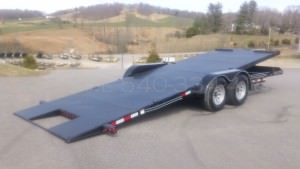Spring Cleaning Essentials: What Dump Trailer Should You Use?

The sun is finally out, the birds are chirping, and it’s time to work on that big project you’ve been dreading all winter. That’s right. It’s time for spring cleaning.
Seventy-six percent of Americans engage in spring cleaning every year. Toilets and doorframes will be spotless, but some spring cleaning requires some heavier duty equipment.
If you’ve got a big project like clearing trees or refurbishing your house, you’ll need a dump trailer to safely and efficiently remove unwanted materials. How do you know what dump trailer to use?
Keep reading to learn about the different types of dump trailers, and which one is right for your project.
Dump Trailer Basics
A dump trailer is a dump truck without the truck. It carries heavy loads and dumps them with powerful lifting mechanisms, but you pull it behind your vehicle.
Hydraulic dump trailers come in many different shapes and sizes. You can choose the width, length, and depth of the trailer to fit your needs.
Size Matters
When deciding on dump trailers, it’s crucial to consider what vehicle you intend to pull it with. Check the towing capacity of your truck or SUV before making your decision.
The most common sizes are 14- and 16-foot dump trailers. These both carry sizeable loads but are still easy to pull behind your vehicle.
You should also keep in mind the size of your intended cargo. You don’t want to take more trips than you have to because you bought a cheap dump trailer instead of the most efficient trailer for the job.
Back End Details
Ease of use is an important priority to have when searching for the best dump trailer. Be sure to check out the amenities on the back end to make sure they meet your needs.
For instance, you may want your dump trailer to have a ramp. Some ramps are detachable, some are folding, and some dump trailers don’t come with ramps.
Most dump trailers have gates in the back, but there are many types of rear gates.
The two most common rear gates are single-door gates and barn door gates. Single-door gates swing out wide, while the barn doors open from the middle and take up less room on the sides.
Consider the space you’re working in when choosing the ramps and gates to your dump trailer.
Framing Fixation
Dump trailers most commonly have three different types of frames. These are channel frames, I-beam frames, and tubular frames.
Channel frames feature a rectangular shape with a side missing for supports to be bolted in. Because of their missing side, they can bend under excessive weight and are commonly found on smaller dump trailers with less weight capacity.
I-beam frames are more durable than channel frames, as their “I” shape prevents bending under pressure. They carry a lot of weight but may wear from excessive loads after long periods.
Tubular frames are the strongest frames; they’re shaped like channel frames without a missing side. Tubular frames are the most reliable when it comes to carrying a lot of weight, as their four sides allow for the least amount of bending under pressure.
Information Dump
After that crash course, you should have a dump trailer in mind that will best aide your spring cleaning endeavors.
Visit our site or send us an email and let Pro-Line Trailers hook you up with the dump trailer for you.





